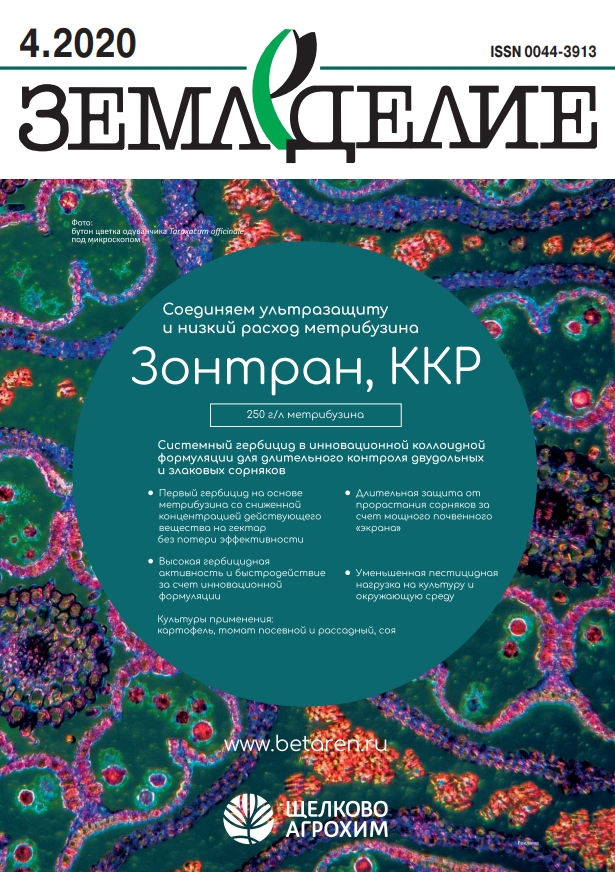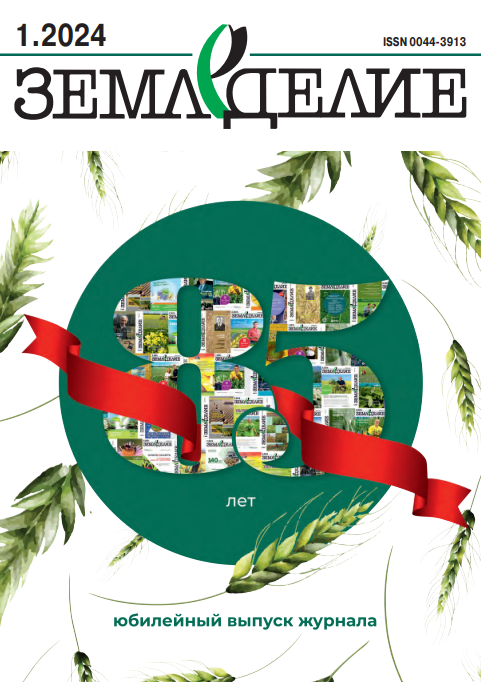Формирование севооборотов и структуры посевных площадей для получения заданного количества продукции с учетом природно-ресурсного потенциала
doi: 10.24411/0044-3913-2020-10405
УДК 631.582
А. С. АКИМЕНКО, доктор сельскохозяйственных наук, зав. лабораторией (e-mail: Адрес электронной почты защищен от спам-ботов. Для просмотра адреса в вашем браузере должен быть включен Javascript.)
Всероссийский научно-исследовательский институт земледелия и защиты почв от эрозии, Курский федеральный аграрный научный центр, ул. Карла Маркса, 70 б, Курск, 305021, Российская Федерация
Исследования проводили с целью разработки методологических основ совершенствования севооборотов для производства заданного количества продукции. Достижение поставленной цели возможно только при наличии необходимых природных ресурсов, в первую очередь тепла и влаги, в зависимости от обеспеченности которыми продуктивность земледельческих зон различается в 1,2…2,9 раза. Формирование структуры посевных площадей ограничено эрозионной опасностью, почвозащитной способностью культур и пригодностью для них почв, поэтому потенциальная продуктивность реализуется на 65…85 %. Увеличению реализации ресурсного потенциала в лесостепной зоне способствует включение в севообороты промежуточных культур, а в сухостепной зоне – ограничение доли чистого пара до 15…20 %. Отчуждение энергии с урожаем сопряжено с расходом почвенного плодородия, что обусловливает снижение продуктивности пашни. При повышении норм азота параллельно с увеличением продуктивности пашни сокращается убыль гумуса аналогично влиянию многолетних трав. Валовой сбор определяют площадь посева и урожайность, которая зависит от места в севообороте и удобрений. Современные сорта и гибриды положительно откликаются на увеличение нормы азота, но при этом усиливается водопотребление и почвенные влагозапасы ко времени колошения зерновых уменьшаются на 30…50 %, относительно неудобренных вариантов, что предопределяет снижение урожайности при отсутствии осадков. Возможности выбора специализации хозяйства ограничивает повышение эрозионной опасности в агроландшафте. Методологическая основа формирования севооборотов заключается в оценке потенциальной продуктивности пашни; выборе специализации по условиям агроландшафта; разработке структуры посевных площадей с учётом влияния на урожайность чередования культур и удобрений.
Ключевые слова: севооборот, структура посевных площадей, влагообеспеченность, продолжительность теплого периода, энергия, азот, гумус.
Для цитирования: Акименко А. С. Формирование севооборотов и структуры посевных площадей для получения заданного количества продукции с учетом природно-ресурсного потенциала // Земледелие. 2020. № 4. С. 19–22. doi: 10.24411/0044-3913-2020-10405.
Formation of crop rotations and structure of sown areas for obtaining the given quantity of product taking into account natural resource potential
A. S. Akimenko
All-Russian Research Institute of Farming and Soil Protection from Erosion,
Kursk Federal Agrarian Scientific Center, ul. Karla Marksa, 70 b, Kursk, 305021, Russian Federation
Abstract. The work aimed to develop methodological fundamentals of improving crop rotations for obtaining the given quantity of product. Achieving this goal is possible only with the necessary natural resources, primarily heat and moisture, depending on the availability of which the productivity of agricultural zones varies 1.2–2.9 times. The formation of the structure of sown areas is limited by erosion danger, soil protecting properties of crops and soil suitability for them and that is why potential productivity is realized by 65–85%. An increase in the realization of the resource potential in the forest-steppe zone is facilitated by the inclusion of intermediate crops in the crop rotation, and in the dry-steppe zone – by the limitation of bare fallow proportion to 15–20%. Energy estrangement with crop yield entails soil fertility discharge which stipulates the decrease in ploughland productivity. In the case of an increase in nitrogen rates, in parallel with an increase in arable land productivity, humus loss decreases similarly to the influence of perennial grasses. Gross yield is determined by the sown area and yield per hectare depending on crop place in a crop rotation and applied fertilizers. Modern varieties and hybrids respond positively to increased nitrogen rates but in this case, water consumption increases and soil moisture supplies by the time of cereal earing decrease by 30–50% as compared with the untreated variants which predetermines yield decrease with the lack of precipitation. The possibilities of choosing the specialization of a farm are limited by the increase in erosion hazard in the agrolandscape. The methodological basis for the formation of crop rotation is to assess the potential productivity of arable land; to choose the specialization in terms of agrolandscape; to develop the structure of sown areas, taking into account the effect of the alternation of crops and fertilizers on the productivity.
Keywords: crop rotation; structure of sown areas; moisture supplies; warm period durability; energy; nitrogen; humus.
Author Details: A. S. Akimenko, D. Sc. (Agr.), head of the laboratory (e-mail: Адрес электронной почты защищен от спам-ботов. Для просмотра адреса в вашем браузере должен быть включен Javascript.).
For citation: Akimenko AS [Formation of crop rotations and structure of sown areas for obtaining the given quantity of product taking into account natural resource potential]. Zemledelie. 2020; (4): 19-22. Russian. doi: 10.24411/0044-3913-2020-10405.










